“I think I can, I think I can!” The mantra made famous by the children’s book, The Little Engine That Could, ran through my mind as the Bernina Express train climbed toward the Swiss Alps. I had chosen to make this particular journey from Tirano, Italy to Chur, Switzerland, because it is the only train that goes up and over the Alps rather than through them. Even more astonishing, it does so without the assistance of a cog system – toothed gears and racks mounted beneath train carriages that are normally employed to conquer steep gradients.
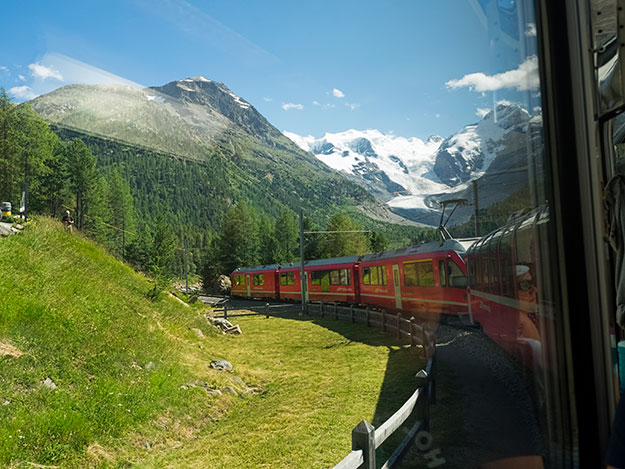
It accomplishes the climb with the assistance of the Brusio Circular Viaduct, a true marvel of modern engineering. I’d read about it beforehand, but didn’t thoroughly appreciate its genius until I saw it in person. The track wound around upon itself in a sweeping circle, like a giant slinky. By spreading out the climb in this manner, the grade is kept below seven percent.
The viaduct, though impressive, was by no means the only spectacular sight on the Bernina Express. Before even stepping onto the train, I had taken advantage of the Bernina’s add-on bus that took me from Lugano, Switzerland, to Tirano. From Lugano, we dipped into Italy and followed the western shore of Lake Como, where green-carpeted mountains tumbled into the aquamarine waters. Pink and red blossoms spilled out of flower boxes on lakefront home and sailboats bobbed in pretty harbors. The bus arrived in Tirano an hour before the train was scheduled to depart, so I stowed my luggage at the station and hotfooted it down to the Sanctuary of the Madonna. It was here in 1504 that Mario Omodei saw the apparition of the Virgin Mary, who promised to end the plague that had devastated the region if a shrine was built in her honor on that exact spot.
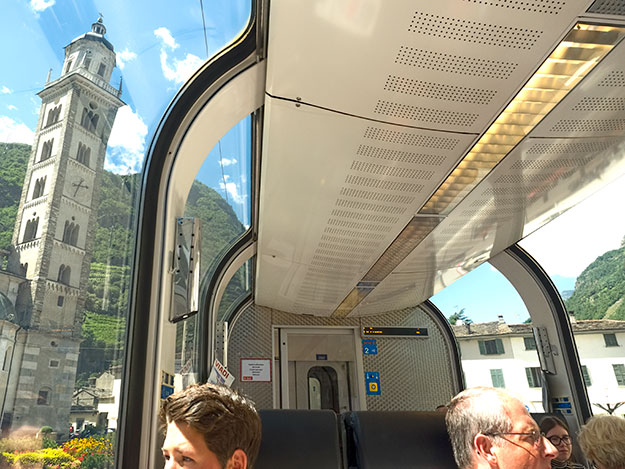
Once on board the train, I had a good laugh over the fact that I hadn’t really needed to make the hike. My bright red Bernina Express train ran right down the middle of the main street of Tirano, passing within a few dozen feet of the Sanctuary. But because I’d also seen the interior, with its rich sculptures, colossal organ, and three cross-shaped naves that are said to be the most beautiful example of the Renaissance in the Lombardy region of northern Italy, I had no regrets.
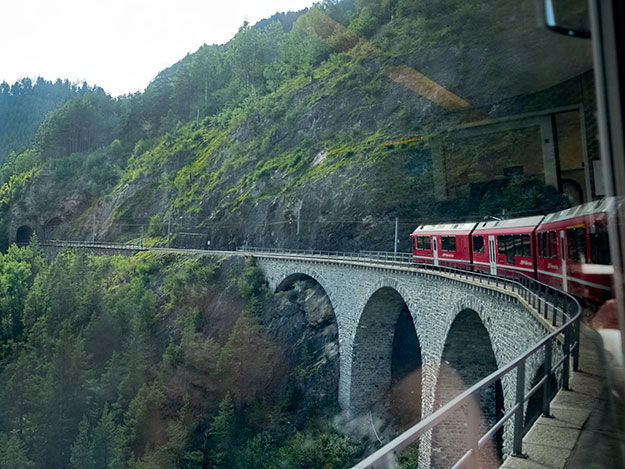
Within minutes we crossed back into Switzerland and began to ascend the flanks of the Alps. The 55 tunnels and 196 bridges we negotiated during the four-hour trip included the 446-foot long Landwasser Viaduct. This signature structure of the Rhaetian Railway is a six-arched, curved limestone viaduct that looked entirely too delicate to support the weight of a train. Its three main pillars, which soar some 213-feet high, were built in 1901-02, using only two cranes and no scaffolding. I held my breath as we crossed, certain we would plunge to a horrible death.

One of very few stops along the way was at Miralago. While passengers boarded, I enjoyed a view of the exquisite turquoise Poschiavo Lake through the train’s wrap-around panoramic windows. Those same windows afforded breathtaking views of the Morteratsch Glacier as we rounded the 180-degree Montebello Curve. The third largest glacier in the Eastern Alps, Morteratsch envelops the 13,284-foot high Piz Bernina and sends a frozen river cascading down its face.

Our little red train climbed ever higher until it reached Lago Bianco. Here, it enjoyed a respite atop the high plateau that marks the watershed in this part of the Alps. To the south, the waters flow to the Adriatic; to the east, into the Black Sea. I smiled as we began our descent. “I thought I could,” rang in my head.
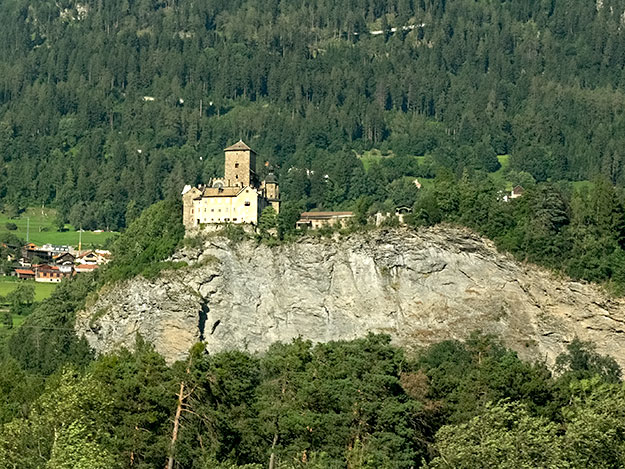
The downhill ride carried us past raging waterfalls, castles perched on hillsides, and mountain villages tucked into chartreuse valleys. We pulled into the station at Chur (pronounced Coor), Switzerland, four hours after departing Tirano, but it had seemed like forty minutes. I was tempted to buy a ticket for a return journey and do it all over again in reverse, and might had done so if Chur had not beckoned. The Bernina Express may be a UNESCO World Heritage Site but Chur, the oldest city in Switzerland, promised that my adventure had only begun.
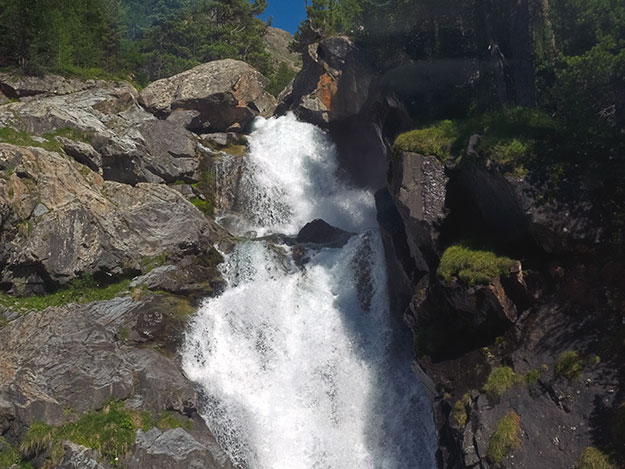
The Bernina Express is operated by Rhaetian Railway and runs year round. The journey from Tirano, Italy to Chur, Switzerland, takes approximately four hours. The add-on bus from Lugano to Tirano, which is available from late March through late October, adds an additional three hours to the journey. While you can find most information about the train on the Rhaetian Railway website, I highly recommend reading the what The Man in Seat 61 has to say before booking. Seat 61 contains information about the Bernina Express that is found nowhere else, such as how to get discount fares and which side of the train to sit on for the best views. Finally, if you’re dreaming of a railway journey in Europe, you may want to consider reading this informative Train Guide to Europe on the Only Once Today blog. Here’s wishing you many years of happy train travel!

Hi! very complete review and impressive pictures!
I´m planning to make the trip northbound on March 21st. My concern is that the arrival time is 18:20, while the sunset is at 18:40! the last part of the trip will be quite dark… do you think I will missing panoramic views? are the most impressive ones at the beggining or at the end of the journey? (from Tirano to Chur).
Thanks!
Hi Juan. Frankly, the views are great throughout the trip, but if I had to pick, I’d say they are best in the beginning and the middle. I think you’ll be OK for even the latter part of they journey, because it stays bright for a while after sunset
Hi Barbara, My family and I are taking the Bernina train from Chur to Tirano this summer and then training to Milan and then Como. Do you know if 1st or second class makes a big difference? We are traveling with teens.
Hi Sarah: Don’t bother paying extra for first class. The second class is very comfortable and includes a meal.
Hi, Barbara! Thank you for this wonderful blog about the Bernina Express. Me & my family are planning to take it from Chur to Tirano. I also read The Man From Seat 61’s advise on how to book it. Going southbound, he said it’s better to sit on the right side of the train. But as he said about the seat reservation, you wouldn’t know where the seats are facing when booking. So i wanted to ask how you booked your seat reservation and where you ended up in the actual Bernina Express train. In the Rhaetian Railway website, the train is pictured horizontally with the seat numbers in descending order from left to right, with the luggage compartment on the right. I read somewhere that the luggage compartments are at the end of each coach. So does that mean that the seats facing the left are the ones facing front? But that would also mean that the seats are numbered in descending order from front to back.
Hi Janet: There is absolutely no way to know which way your seat faces or what side you will be sitting on before you board the train. However I can say this – in my opinion, both sides are equally good. And if you do a round-trip journey, you’ll get to see both sides.
Thank you for the travelogue and photos. Your photos have rekindled may desire to go back to Switzerland (toured the entire country in May/Jun 2014) now I will make it happen. Maybe the next trip will be in wintertime with more snow. I am a amateur photographer and the landscapes of Switerland are one of favorite subjects.
Happy travels.
Hi Mark: Thanks so much for your comment. I would love to go back and take the train ride again in the winter time. I think the scenery would be a wonderland in the snow. Hope you get to go!